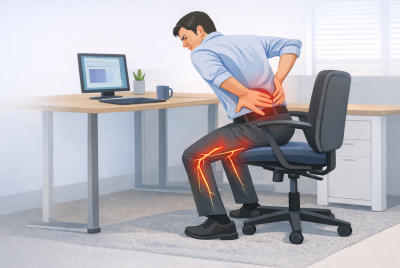Pain Management for Sciatica
Explore effective pain management for sciatica! Discover personalized strategies for relief and improved well-being, from exercises to holistic approaches. This guide delves into diverse strategies to provide relief and enhance overall well-being. From understanding the intricacies of sciatica to exploring traditional and alternative therapies, this article serves as a proactive resource. As someone who has navigated the challenges of sciatic pain, I share insights, research, and personal experiences to empower individuals on their journey to effective and personalized sciatica pain management.
Understanding Sciatica
Understanding sciatica is crucial; it stems from compression or irritation of the sciatic nerve, causing pain, tingling, and numbness. Various factors, such as herniated discs or spinal stenosis, contribute to this condition. Recognizing symptoms beyond pain, like muscle weakness, aids in comprehensive management. Consulting healthcare professionals ensures accurate diagnosis, paving the way for tailored treatment plans.
Causes of Sciatica
Sciatica can arise from various causes, including herniated discs, spinal stenosis, or injury. Exploring the underlying factors contributes to a more nuanced approach to pain management.
Symptoms Beyond Pain
While pain is a predominant symptom, sciatica may also manifest as muscle weakness, tingling sensations, and difficulty in controlling leg movements. Recognizing these symptoms aids in comprehensive management.
Diagnosis and Consultation
Consulting a healthcare professional is not only advisable but paramount in the journey of managing sciatic pain. Diagnosing the root cause through imaging tests ensures a tailored and effective treatment plan.
One Movement for Instant Sciatica Pain Relief
Holistic Consultation Approach
An in-depth discussion with a healthcare provider helps uncover lifestyle factors, stressors, and other potential contributors to sciatic pain. A holistic approach enhances the precision of the management plan.
Traditional Pain Relief Methods
While over-the-counter medications provide temporary relief, a broader understanding of traditional pain relief methods is essential for a well-rounded approach.
Exploring Topical Analgesics
Topical analgesics, such as creams and patches, can offer localized relief. Understanding their application and effectiveness enhances their role in managing sciatic pain.
Combining Medications for Synergy
The judicious combination of medications, under professional guidance, can provide a synergistic effect, addressing different aspects of sciatic pain simultaneously.
Physical Therapy for Sciatica
Physical therapy remains a cornerstone in sciatica management. Expanding on this aspect, let’s explore specific exercises and the role of a physical therapist in more detail.
Tailored Exercise Regimens
Physical therapists design exercise regimens tailored to individual needs. Emphasizing the importance of consistency and progression ensures optimal results.
Hands-On Techniques from Therapists
Beyond exercises, physical therapists employ hands-on techniques like massage and manipulation. These personalized interventions contribute significantly to pain relief.
Ergonomics and Lifestyle Adjustments
The impact of ergonomics and lifestyle on sciatic pain management cannot be overstated. Let’s delve deeper into specific adjustments and their positive effects.
Ergonomic Workspaces at Home and Office
Creating an ergonomic workspace involves not just the right chair but also proper desk height and computer monitor positioning. Small adjustments yield substantial benefits.
Sleeping Positions for Sciatica Relief
Exploring optimal sleeping positions and the role of pillows in supporting spinal alignment contributes to better sleep quality and reduced sciatic discomfort.
Alternative Therapies
The realm of alternative therapies for sciatica relief is vast. Delving into specific modalities and their effectiveness enhances the understanding of these non-conventional approaches.
Precision in Acupuncture Points
Understanding the precision of acupuncture points and the philosophy behind this ancient practice sheds light on its potential benefits for sciatic pain.
Chiropractic Care: Beyond Adjustments
Chiropractic care extends beyond spinal adjustments. Exploring soft tissue therapies and the holistic approach of chiropractors provides a comprehensive view of their efficacy.
Nutrition and Supplements
Dietary choices and supplements play a pivotal role in managing inflammation, a key contributor to sciatic pain. Unpacking this aspect sheds light on practical dietary modifications.
Anti-Inflammatory Diet Insights
A diet rich in anti-inflammatory foods, such as fatty fish and leafy greens, contributes to reduced inflammation and, consequently, less sciatic pain.
Supplement Dosage and Timing
Understanding the optimal dosage and timing of supplements, including vitamins and minerals, ensures their maximum efficacy in supporting sciatica management.
Mind-Body Connection
The intricate link between the mind and sciatic pain necessitates a deeper exploration. Unpacking stress management and its impact on sciatica provides a holistic perspective.
Mindfulness Techniques for Everyday Life
Incorporating mindfulness into daily life involves more than meditation. Practical techniques for cultivating mindfulness in various activities contribute to stress reduction.
Biofeedback and Pain Perception
Biofeedback actively influences pain perception. This technique empowers individuals to modify their physiological responses, offering a tangible method for managing sciatic pain. By enhancing self-awareness and control over bodily functions, biofeedback becomes a valuable tool in the holistic approach to sciatica, providing individuals with the means to participate actively in their pain management journey.
Medication Options
Prescription medications offer a more potent approach to sciatic pain management. A nuanced understanding of specific medications and their considerations is crucial.
Balancing Pain Relief and Side Effects
Balancing the benefits of pain relief with potential side effects involves informed decision-making. This section explores the importance of open communication with healthcare providers.
Long-Term Medication Considerations
Understanding the long-term implications of certain medications, such as opioids, emphasizes the need for a comprehensive approach to sciatic pain management.
Invasive Procedures
For severe cases, invasive procedures may become a consideration. Elaborating on surgical options and non-surgical interventions offers a comprehensive view of the spectrum of choices.
Risks and Benefits of Surgery
Navigating the risks and benefits of surgery, including the potential for postoperative rehabilitation, is vital for individuals contemplating invasive procedures for sciatic relief.
Advanced Non-Surgical Interventions
Beyond surgery, advancements in non-surgical interventions, such as nerve blocks and radiofrequency ablation, offer alternatives with fewer associated risks.
Preventive Measures
Preventing future sciatic episodes involves proactive measures. Expanding on lifestyle adjustments, exercise routines, and ongoing self-care provides a roadmap for long-term relief.
Consistency in Exercise Routine
Maintaining a consistent exercise routine, even after initial relief, ensures ongoing support for spinal health and reduces the likelihood of sciatic flare-ups.
Educational Workshops and Resources
Exploring educational workshops and resources empowers individuals with the knowledge to make informed lifestyle choices, fostering a proactive approach to sciatica prevention.
Real-Life Success Stories
Real-life success stories resonate deeply. Expanding on these narratives provides readers with diverse experiences, showcasing the resilience and adaptability of individuals managing sciatica.
Diverse Paths to Success
Highlighting varied approaches to success, including a combination of therapies, lifestyle changes, and emotional resilience, offers readers a spectrum of strategies to explore.
Community Support and Shared Journeys
Acknowledging the power of community support and shared journeys reinforces the idea that individuals with sciatica are not alone. Connecting with others can be a source of motivation.
Frequently Asked Questions (FAQs)
Can sciatica be completely cured?
A complete cure for sciatica varies, but proactive management through lifestyle adjustments and targeted treatments often leads to substantial symptom improvement. Healthcare professionals are crucial in guiding individuals toward effective strategies for alleviating sciatic pain and enhancing overall well-being. It’s a journey of exploration and personalized care tailored to each person’s unique needs.
Are there any herbal remedies for sciatica?
While some individuals explore herbal remedies like turmeric and Devil’s Claw for sciatica relief, it’s vital to consult with healthcare professionals before attempting such alternatives. They provide guidance on safe and effective herbal interventions, ensuring a well-informed approach to managing sciatic pain and minimizing potential risks associated with self-administered herbal remedies.
Can weather changes affect sciatic pain?
Weather changes may impact sciatic pain for some individuals, with increased discomfort reported during shifts. Though anecdotal, staying mindful of weather-related patterns allows better pain management strategies. Individuals experiencing such sensitivities may find it helpful to adapt their routines or treatments accordingly, recognizing the potential influence of weather changes on their sciatic symptoms.
Is it safe to exercise with sciatica?
Exercising with sciatica is generally safe and can be beneficial. Consult with healthcare professionals or physical therapists to design a safe and effective exercise routine tailored to your condition. Proper guidance ensures that exercises target sciatic relief without exacerbating symptoms, promoting overall well-being, and contributing to the management of sciatica.
How can emotional well-being impact sciatic pain?
Emotional well-being significantly impacts sciatic pain. Stress and anxiety can exacerbate symptoms, underscoring the importance of holistic approaches addressing both physical and emotional aspects. Managing emotional health through mindfulness, relaxation techniques, and counseling may complement traditional treatments, fostering a comprehensive strategy for individuals seeking relief from the challenges of sciatica.
Pain Management for Sciatica – Conclusion
In conclusion, effective pain management for sciatica requires a diverse and personalized approach. Through proactive lifestyle adjustments, targeted treatments, and holistic well-being practices, individuals can find relief and regain control over their lives. The journey is unique for each person, emphasizing the need for open communication with healthcare professionals and a willingness to explore various strategies. By embracing a combination of physical therapy, alternative therapies, and a focus on emotional well-being, individuals with sciatica can navigate their path towards improved quality of life. Remember, it’s a journey of resilience, and success lies in discovering what works best for you.
Disclaimer
Please note that the information provided in this article is for informational purposes only and should not replace professional medical advice. If you’re experiencing sciatica pain or any health concerns, it’s advisable to consult a healthcare professional for proper diagnosis and treatment.






